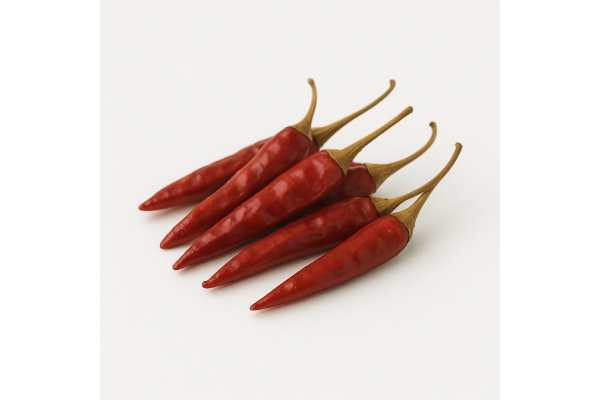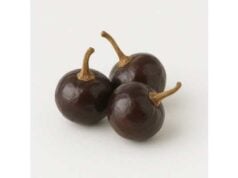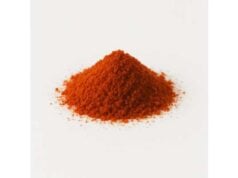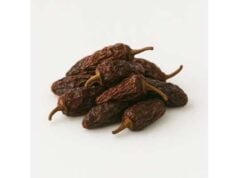
Chile de Árbol is a small, slender red chile with a surprisingly big presence. Common in central and northern Mexico, these thin pods deliver bright, clean heat, a hint of smokiness, and a slightly nutty flavor that can transform simple dishes into something vivid and memorable. Dried chiles de árbol show up in salsas, table sauces, chile oils, soups, and stews; a single pod can change the entire character of a dish.
Nutritionally, chile de árbol is similar to other hot red peppers: very low in calories yet concentrated in vitamin C, vitamin A precursors, and protective plant compounds. Its heat comes from capsaicin, a bioactive compound linked with potential metabolic, cardiovascular, and pain-modulating effects, but also with digestive discomfort in some people when used heavily.
This article explores what chile de árbol is, how it compares to other chiles, what its nutrition and health research suggest, who needs to be cautious, and practical ways to use it safely in everyday cooking.
Fast Facts
- Chile de Árbol is a moderately hot dried red chile (roughly 15,000–30,000 Scoville units) rich in capsaicin, vitamin C, and carotenoids.
- Regular chili pepper consumption is associated with modest benefits for metabolic and cardiovascular health, but effects depend on overall diet and lifestyle.
- A practical culinary amount for most adults is about 1–3 small dried pods (around 1–3 grams total) per serving, used a few times per week.
- Very spicy foods can trigger heartburn, pain, or digestive upset, especially in people with reflux, irritable bowel syndrome, or ulcers.
- Individuals with sensitive digestion, certain gastrointestinal or heart conditions, or previous severe reactions to chili should limit high-intensity chile dishes and seek medical advice before using capsaicin therapeutically.
Table of Contents
- Chile de Árbol origins and culinary role
- Chile de Árbol nutrition and active compounds
- Chile de Árbol research backed benefits
- Digestive risks allergies and interactions
- Selecting quality sustainability and storage
- Cooking with chile de arbol and preserving nutrients
- Portion guidance comparisons and faqs
Chile de Árbol origins and culinary role
Chile de Árbol belongs to the Capsicum annuum species, the same broad family as jalapeños, cayenne, and many bell peppers. The name literally means “tree chile” in Spanish, a reference to the plant’s woody stems and upright, branching growth habit. Historically cultivated in several Mexican states, it has become a staple in Mexican and Tex-Mex cooking and is increasingly familiar worldwide through bottled hot sauces and dried chile assortments.
The pods are long and thin, usually 5–7 centimeters in length, with a pointed tip and smooth, glossy skin. When fresh, they are green and herbaceous; when fully ripe and dried, they become bright red to brick red. At that stage, their heat level typically falls around 15,000–30,000 Scoville Heat Units, hotter than jalapeños but milder than many Thai or habanero chiles. This places chile de árbol in a “medium-hot” range where a small number of pods can season a family dish without overwhelming it.
Flavor-wise, chile de árbol stands out for its clean, direct heat, subtle smokiness, and gentle nuttiness. Unlike ancho or guajillo chiles, which have deep raisin or dried fruit notes, chile de árbol is sharper and more linear. That character makes it ideal when you want to add bright heat without drastically changing the underlying flavor of a dish.
Common culinary uses include:
- Bright red table salsas made with toasted chiles, garlic, and tomatoes.
- Infused chile oils and vinegars for drizzling over tacos, soups, and grilled vegetables.
- Finishing heat for pozole, bean dishes, braised meats, and brothy soups.
- Ground chile flakes for sprinkling over pizza, eggs, roasted potatoes, or popcorn.
Chile de árbol is typically sold dried, either whole or ground. Whole pods offer more flexibility: you can toast them, rehydrate and blend them, or crumble them into flakes. Ground chile de árbol is convenient but loses aroma more quickly if not stored well.
In many Mexican kitchens, chile de árbol shares space with milder chiles like ancho and guajillo and with slightly different medium-hot chiles like puya. Each brings its own heat profile and aromatic spectrum, and cooks often combine them to build layers of flavor. Understanding chile de árbol’s role within this broader family helps you use it strategically rather than just to “make things spicy.”
Chile de Árbol nutrition and active compounds
Chile de Árbol, like other hot red peppers, is very low in calories and fat yet surprisingly rich in certain vitamins and plant compounds. Exact values vary with growing conditions and whether the chile is fresh or dried, but the overall profile is consistent with other small hot chiles.
On a fresh weight basis, hot green or red chili peppers provide roughly 30–40 kilocalories per 100 grams, minimal fat, modest protein, and mostly carbohydrate in the form of natural sugars and some fiber. A single small chile weighs only a few grams, so the calorie contribution to a meal is negligible. When dried, water is removed and nutrients become more concentrated per gram, but the actual amounts used in cooking are still tiny, so energy intake remains low.
Micronutrient-wise, chile de árbol and similar peppers typically contain:
- Vitamin C: A standout nutrient in chili peppers, often reaching several hundred percent of daily needs per 100 grams. Even a small portion can meaningfully add to daily vitamin C intake, though some is lost with drying and cooking.
- Provitamin A carotenoids: Including beta-carotene and related compounds that contribute to eye health, immune function, and skin integrity. Their levels tend to increase as the pepper ripens and turns from green to red.
- Vitamin B6 and folate: Present in smaller amounts, supporting energy metabolism and nervous system function.
- Vitamin K and vitamin E: Generally in modest amounts but still contributing to overall intake.
- Minerals: Such as potassium, magnesium, and small amounts of calcium and iron, which support nerve function, muscle contraction, bone health, and oxygen transport.
The most distinctive features, however, are the bioactive compounds:
- Capsaicinoids: A family of alkaloids that includes capsaicin and dihydrocapsaicin. These molecules bind to the TRPV1 receptor in sensory nerves, creating the familiar burning sensation but also triggering changes in circulation, thermogenesis, and pain signaling.
- Carotenoids: Beyond provitamin A, red peppers contain pigments like capsanthin and capsorubin, which act as antioxidants and contribute to the intense red color.
- Polyphenols and flavonoids: Including quercetin and luteolin derivatives, which may influence inflammation and oxidative stress pathways.
- Volatile aroma compounds: Responsible for subtle smoky, grassy, or nutty notes released when chiles are toasted or fried.
Drying and toasting affect these compounds in different ways. Air-drying preserves most capsaicin and many carotenoids but can reduce vitamin C significantly. Gentle toasting in a dry pan enhances aroma and flavor by developing volatile compounds and light roasted notes. Intense or prolonged heating can degrade both delicate vitamins and some aromatics, sometimes making the chile taste flat or bitter.
Because Chile de Árbol is used in small culinary quantities, its main nutritional role is not as a major source of calories or macronutrients but as a concentrated carrier of capsaicin, carotenoids, polyphenols, and flavor. It can help make nutrient-dense foods—like beans, vegetables, and whole grains—more appealing, which indirectly supports healthier eating patterns.
Chile de Árbol research backed benefits
Most research does not isolate Chile de Árbol specifically; instead, it examines chili peppers in general, hot red peppers, or capsaicin itself. Nevertheless, the key findings are highly relevant because chile de árbol is a typical capsaicin-rich pepper.
The best-studied areas include cardiometabolic health, weight management, pain modulation, and overall mortality.
Large population studies from different countries have found that people who regularly eat hot red chili peppers tend to have slightly lower rates of death from cardiovascular and certain other causes compared with those who rarely eat them. These studies cannot prove cause and effect, but they suggest that chili pepper consumption is at least a marker of more favorable long-term outcomes rather than harm in most populations.
Cardiometabolic research has looked at both whole peppers and purified capsaicin. Experimental and clinical studies suggest several potential benefits:
- Modest improvements in blood lipids (for example, small reductions in total cholesterol and triglycerides) in some groups, especially when capsaicin is used as an adjunct to lifestyle measures.
- Increased thermogenesis and slight increases in energy expenditure, which may contribute to easier weight maintenance when combined with appropriate diet and activity.
- Support for microcirculation and endothelial function, which may play a role in cardiovascular resilience.
Meta-analyses of randomized trials investigating capsaicin or chili-based interventions in people with metabolic syndrome or related conditions often report small beneficial changes in lipid profiles, weight, or waist circumference. However, the effect sizes are generally modest, and results vary by study, reflecting differences in dose, preparation, and participant characteristics.
For weight management, capsaicin appears to have several overlapping effects: it may slightly reduce appetite in the short term, increase fat oxidation, and enhance diet-induced thermogenesis. In practical terms, these changes are small relative to total energy balance but may contribute to weight control when integrated into a thoughtful nutrition and movement plan.
Capsaicin is also well known for its analgesic properties. Topical capsaicin creams and patches are used medically for conditions such as neuropathic pain and osteoarthritis. The mechanism involves repeated activation and subsequent desensitization of pain fibers, which over time reduces pain signaling in targeted areas. This medical use does not mean that eating large amounts of chile de árbol will have the same effect, but it highlights the potency of capsaicin as a bioactive compound.
There is emerging research on neuroprotective and cognitive aspects, as well as on interactions between dietary capsaicin and the gut microbiome. Early findings suggest that capsaicin can influence inflammatory pathways and microbial composition in ways that may be beneficial, though this work is still evolving and not specific to any single chili variety.
Overall, the evidence supports a view of hot peppers like chile de árbol as potentially helpful components of a nutrient-dense diet, particularly in the context of traditional eating patterns that emphasize legumes, vegetables, and minimally processed foods. The benefits are not dramatic “fixes” but gentle nudges in a favorable direction, and they depend on moderation and context.
Digestive risks allergies and interactions
Alongside potential benefits, chile de árbol carries real risks for some people, mainly through its capsaicin content. The same compound that provides warmth and flavor can irritate delicate tissues when exposure is intense or frequent.
The most common issues are digestive symptoms:
- Burning or pain in the mouth and throat during or after eating.
- Heartburn and reflux, especially in people with gastroesophageal reflux disease (GERD).
- Stomach pain, nausea, or cramping.
- Loose stools or diarrhea, particularly when large amounts of hot chiles are eaten at once.
For individuals with existing conditions such as gastritis, peptic ulcer disease, inflammatory bowel disease, or irritable bowel syndrome, spicy foods may aggravate symptoms. Some people experience an acute flare-up after particularly spicy meals, while others find that frequent smaller exposures cause cumulative irritation.
There is ongoing scientific debate about cancer risk at very high chili intakes. Some regional studies, especially in populations with extremely spicy diets, have reported associations between heavy chili consumption and increased risk of cancers in the upper digestive tract. Others have not replicated these findings, and some large analyses suggest that overall chili intake is associated with neutral or even favorable outcomes for mortality. It is possible that extremely high, chronic exposures in the context of other risk factors (such as alcohol, smoking, or specific infections) carry more risk than the moderate intakes common in many home kitchens.
Allergic and hypersensitivity reactions, while less frequent, can occur. These may present as:
- Hives or itching after eating spicy foods.
- Swelling of the lips, tongue, or throat.
- Wheezing or difficulty breathing in more severe cases.
- Contact dermatitis or burning when chili juice or powder touches the skin or eyes.
Inhalation of chile de árbol dust or smoke from toasting chiles can also irritate the eyes and respiratory tract, leading to coughing, tearing, or a burning sensation.
Medication interactions are another consideration:
- Capsaicin’s effect on metabolism and blood vessels may theoretically interact with some blood pressure or heart medications, although typical dietary amounts are unlikely to cause large shifts on their own.
- Chili peppers may affect how quickly certain drugs are absorbed or metabolized in the gut, but this remains an evolving research area.
- People on blood thinners or antiplatelet medications may worry about interactions, though culinary use of chile de árbol is not generally considered a major factor. The main caution is to avoid untested supplements or concentrated extracts without medical supervision.
Pregnant and breastfeeding individuals can usually enjoy moderate spicy foods if they tolerate them well, but intense heat may worsen reflux, which is already common in pregnancy. Infants and young children often have more sensitive digestion and may react strongly to spicy foods; there is no nutritional need to introduce very hot chiles early.
Those most likely to need caution or medical advice before increasing chile de árbol intake include:
- People with frequent heartburn, ulcers, or significant digestive disease.
- Individuals with a history of severe reactions to chili or capsaicin-containing products.
- Patients with complex medication regimens for cardiovascular, metabolic, or bleeding disorders.
For most healthy adults, moderate amounts of chile de árbol used in food are unlikely to cause harm and may be well tolerated. Problems tend to appear when heat is pushed far beyond comfort, or when underlying conditions are present and not accounted for.
Selecting quality sustainability and storage
Because chile de árbol is usually purchased dried, choosing good quality and storing it correctly makes a noticeable difference in flavor, safety, and shelf life.
When buying whole dried chiles, look for:
- Color: Vibrant red to deep brick red, without excessive browning or grayish patches. Very dull or faded pods often indicate age or poor storage.
- Texture: Firm but slightly flexible, not brittle enough to shatter instantly, unless they are very thin. Avoid pods that feel soft or moist, which can signal mold risk.
- Surface: Smooth skin without visible mold, insect damage, or excessive dust.
- Aroma: A fresh, slightly smoky, fruity smell when a pod is broken or cut. Musty or moldy odors are signs to avoid.
For ground chile de árbol, packaging matters. Opaque or dark containers help protect against light, and tight seals limit oxygen and moisture. Bulk bins can be tempting, but they expose the spice to air and light; freshness depends heavily on turnover and handling. If you use chile de árbol regularly, buying smaller amounts more often can keep flavor at its best.
Authenticity is another issue. While “chile de árbol” is a fairly specific term, mislabeling can still occur, especially in generic “red pepper” blends. If you want to be sure you are getting true chile de árbol rather than a mix of different chiles, choose suppliers who specify the variety and origin and who specialize in Mexican ingredients.
From a sustainability perspective, chile de árbol is cultivated largely by small and medium-scale farmers. Environmental impacts depend on local practices, including water use, pesticide management, and soil conservation. Certifications like organic or fair trade are still less common for dried chiles than for coffee or cocoa, but they are appearing more often and can signal reduced pesticide use or better labor practices.
To store chile de árbol at home:
- Keep both whole pods and ground chile in airtight containers in a cool, dry, dark place, such as a cupboard away from the stove.
- Avoid storing spices above the oven or near heat sources, where repeated warming and cooling can accelerate loss of volatile compounds.
- Do not leave the container open near steaming pots; humidity can make dried chiles clump or encourage microbial growth.
Whole dried chile de árbol can maintain acceptable quality for a year or more when stored well, though some aroma and color will gradually fade. Ground chile usually loses fragrance faster—often within several months after opening. If the pepper smells flat, musty, or “dusty” instead of bright and spicy, it is likely past its peak.
Freezing whole dried chiles is an option for long-term storage; a well-sealed freezer bag can slow down oxidation, and you can use the pods straight from the freezer for toasting or blending.
Thoughtful sourcing and storage make it more likely that you are getting the intended flavor, heat level, and phytochemical content from chile de árbol, and they reduce the risk of spoilage or contamination.
Cooking with chile de arbol and preserving nutrients
Cooking with chile de árbol is as much about technique as it is about quantity. Small changes in how you toast, soak, and blend the chiles can shift both flavor and perceived heat.
Toasting is a classic first step. Gently heating whole pods in a dry skillet over medium-low heat for a few seconds per side brings out their aromatic oils and a subtle smoky depth. The key is to keep the chiles moving and to remove them from heat as soon as they darken slightly and become fragrant. If they blacken or smoke heavily, they can turn bitter and harsh, and the fumes may irritate eyes and lungs.
After toasting, many recipes call for rehydrating chiles in hot water or broth before blending. Soaking for 10–20 minutes softens the flesh and allows flavors to bloom. You can adjust the heat by:
- Removing some or all of the seeds and inner membranes before soaking (these parts carry significant heat and some capsaicin).
- Combining chile de árbol with milder dried chiles such as guajillo or ancho to create more complex, less aggressive sauces.
- Controlling how many pods you use per batch, remembering that they are more potent than their size suggests.
From a nutrient standpoint, vitamin C is highly heat-sensitive and will decline with prolonged cooking. Carotenoids and many polyphenols are more resilient and can even become more bioavailable when chiles are cooked with a bit of fat. To get the best of both worlds, you can:
- Add some of the chile de árbol later in the cooking process, especially for quick-cooking dishes.
- Include a small amount of raw or lightly blended chile in salsas or condiments served alongside cooked foods.
- Pair chiles with healthy fats such as olive oil, avocado, or nuts to support absorption of fat-soluble compounds like carotenoids.
Practical ways to use chile de árbol include:
- Simple chile oil: Toast a few pods lightly, then steep them in warm neutral or olive oil with garlic and a pinch of salt. Strain if desired. Use in small amounts over roasted vegetables, soups, or grain bowls.
- Everyday table salsa: Blend toasted chile de árbol with tomatoes or tomatillos, onion, garlic, and a little vinegar or lime juice. Adjust heat by combining with milder chiles or reducing the number of árbol pods.
- Flavor base for soups and stews: Blend a small quantity of rehydrated chile de árbol into the base of bean soups, vegetable stews, or braised meats to add warmth and color without overwhelming the dish.
Because capsaicin is oil-soluble, it can cling to cutting boards, knives, and hands. Wearing gloves while handling large quantities, avoiding touching your eyes or face, and washing surfaces with soapy water after preparation helps prevent accidental burns. Dairy products like yogurt or milk-based sauces can help moderate heat in finished dishes because casein binds capsaicin.
The goal is not to chase maximum heat but to find a level where chile de árbol sharpens flavors, enhances enjoyment, and fits comfortably within your personal tolerance and digestion.
Portion guidance comparisons and faqs
Translating research findings and safety considerations into kitchen-friendly guidance starts with understanding scale. Dried chile de árbol pods are light; a single small pod may weigh around 1 gram or less, depending on size and moisture content. Ground chile is similarly light, with 1 teaspoon usually weighing a couple of grams.
For most healthy adults who tolerate spicy foods, sensible guidelines might look like:
- Occasional use: A few pods in a shared dish once or twice a week is unlikely to pose significant health concerns and may contribute beneficial plant compounds.
- Regular, moderate use: Using 1–3 small dried pods (or an equivalent pinch of ground chile de árbol) in daily or near-daily cooking is reasonable for many people, provided it does not cause digestive discomfort.
- High use: Large quantities of very spicy food at most meals or frequent eating challenges are more likely to cause irritation or interact with underlying conditions and are not necessary for potential health benefits.
Children, older adults, and people with smaller body size or sensitive digestion may need smaller amounts or fewer exposures. There is no specific “required” intake of hot peppers; they are optional flavorings rather than essential nutrients.
Comparing chile de árbol to other peppers:
- Heat level: Chile de árbol (about 15,000–30,000 Scoville units) is hotter than jalapeño (roughly 3,000–8,000) but generally milder than cayenne or many Thai chiles, which can reach 30,000–50,000 or more.
- Flavor: Jalapeños are grassy and crisp when fresh; ancho chiles are sweet and raisin-like; guajillos are fruity and tangy. Chile de árbol is sharper and more linear, making it well suited to bright, clean-tasting salsas and oils.
- Form: Chile de árbol is most often used dried and whole, whereas jalapeños are frequently used fresh and habaneros often appear both fresh and in hot sauces.
Common questions include:
Is chile de árbol good for weight loss?
On its own, no food guarantees weight loss. Capsaicin can slightly raise energy expenditure and may reduce appetite for some people, but these effects are modest. Weight management still depends mainly on overall energy intake, food quality, physical activity, sleep, and stress. Chile de árbol can be part of a flavor strategy that makes healthy foods more satisfying.
Are the seeds dangerous or unhealthy?
The seeds themselves are not toxic, but they and the surrounding membranes hold much of the pepper’s heat. Removing them is mainly about controlling spiciness and reducing the risk of digestive discomfort.
Is dried chile de árbol less nutritious than fresh?
Drying reduces vitamin C but concentrates carotenoids and many other compounds per gram. In practice, you use much less dried chile than fresh. The most important factors for health are the overall dish and diet, not the difference between fresh and dried in isolation.
Can chile de árbol help with pain if I eat more of it?
Medical use of capsaicin for pain relief typically involves topical preparations with carefully controlled doses, applied under professional guidance. Eating very large amounts of chile de árbol in hopes of pain relief can instead cause digestive problems and is not recommended.
Is it safe during pregnancy or while breastfeeding?
In culinary amounts, spicy foods are generally considered acceptable if they do not cause significant reflux or discomfort. However, tolerance can change during pregnancy, and very spicy foods may worsen heartburn. Anyone with concerns should discuss their specific situation with a healthcare professional.
Within these boundaries, chile de árbol can be enjoyed as a distinctive spice that adds both sensory pleasure and a modest contribution to a varied, plant-rich diet.
References
- Health Implications of Capsaicin: Weighing the Benefits and Risks of Spicy Foods 2025 (Systematic Review)
- Dietary Capsaicin: A Spicy Way to Improve Cardio-Metabolic Health? 2022 (Systematic Review)
- Lipid-Lowering Efficacy of the Capsaicin in Patients With Metabolic Syndrome: A Systematic Review and Meta-Analysis of Randomized Controlled Trials 2022 (Systematic Review and Meta-analysis)
- Chili Pepper Intake and All-Cause and Disease-Specific Mortality: A Meta-Analysis of Prospective Cohort Studies 2022 (Meta-analysis)
- The Association of Hot Red Chili Pepper Consumption and Mortality: A Large Population-Based Cohort Study 2017 (Cohort Study)
Disclaimer
This article is for general educational purposes and does not provide personalized medical, nutritional, or safety advice. Chile de Árbol and other hot peppers can affect individuals differently, especially in the presence of digestive disorders, cardiovascular disease, metabolic conditions, pregnancy, or complex medication regimens. Do not use chile de árbol or capsaicin supplements as a replacement for prescribed treatments or professional guidance. If you have ongoing symptoms, chronic illness, or questions about how spicy foods fit into your health plan, consult a qualified healthcare professional or registered dietitian before making significant changes to your diet.
If you found this overview helpful, you are warmly invited to share it on Facebook, X (formerly Twitter), or any other platform you prefer. Thoughtful sharing supports our ability to keep producing careful, evidence-informed articles on food, nutrition, and health.










